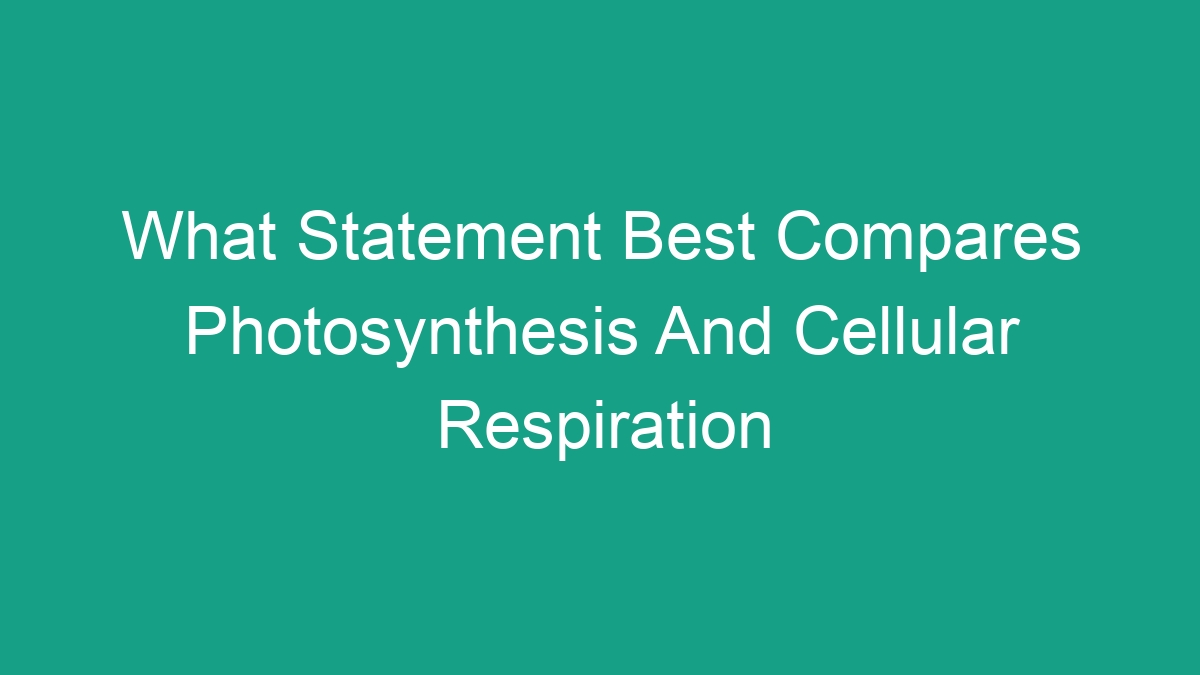
Introduction
Photosynthesis and cellular respiration are two fundamental processes that are essential for the survival of living organisms. Both processes play crucial roles in the cycling of energy and matter within ecosystems, and they are intricately interconnected. While photosynthesis is the process by which plants, algae, and some bacteria convert light energy into chemical energy, cellular respiration is the process by which organisms release energy from food molecules. In this article, we will delve into the key similarities and differences between photosynthesis and cellular respiration, and discuss why understanding these processes is essential for our understanding of the natural world.
Comparing the Processes
Photosynthesis is the process by which green plants, algae, and some bacteria convert light energy, usually from the sun, into chemical energy in the form of glucose (C6H12O6) and oxygen gas (O2). This process takes place in the chloroplasts of plant cells, with the help of pigments such as chlorophyll. The overall chemical equation for photosynthesis can be summarized as:
6CO2 + 6H2O + light energy –> C6H12O6 + 6O2
On the other hand, cellular respiration is the process by which organisms release energy from food molecules, such as glucose, in the presence of oxygen. This process occurs in the mitochondria of cells and involves a series of complex biochemical reactions. The overall chemical equation for cellular respiration can be summarized as:
C6H12O6 + 6O2 –> 6CO2 + 6H2O + ATP (energy)
Key Similarities
While photosynthesis and cellular respiration are distinct processes with different functions, they are connected through the exchange of gases, particularly oxygen and carbon dioxide. In photosynthesis, plants take in carbon dioxide from the atmosphere and release oxygen as a byproduct. Conversely, in cellular respiration, organisms take in oxygen and release carbon dioxide as a byproduct. This exchange of gases between photosynthesis and cellular respiration is essential for maintaining the balance of atmospheric gases, and ultimately, for sustaining life on Earth.
Moreover, both photosynthesis and cellular respiration are vital for the production and utilization of ATP (adenosine triphosphate), which is the primary energy currency in living organisms. While photosynthesis generates glucose and other organic compounds, which are then broken down during cellular respiration to produce ATP, cellular respiration is directly responsible for the production of ATP through a process known as oxidative phosphorylation. This reciprocal relationship between photosynthesis and cellular respiration demonstrates the interconnectedness of these processes and their importance in the flow of energy within ecosystems.
Key Differences
Despite their interconnectedness, photosynthesis and cellular respiration exhibit several key differences in terms of their chemical reactions, locations within cells, and the utilization of energy.
One of the primary differences lies in the inputs and outputs of each process. In photosynthesis, the inputs are carbon dioxide, water, and light energy, which are used to produce glucose and oxygen as the outputs. On the other hand, cellular respiration takes glucose and oxygen as inputs, and produces carbon dioxide, water, and ATP as the outputs. This fundamental distinction in inputs and outputs reflects the contrasting goals of each process – photosynthesis is primarily an anabolic process that builds organic molecules, while cellular respiration is primarily a catabolic process that breaks down organic molecules to release energy.
Another key difference is the location within cells where each process occurs. Photosynthesis occurs in the chloroplasts of plant cells, specifically in the thylakoid membranes and the stroma. In contrast, cellular respiration takes place in the mitochondria of eukaryotic cells, specifically in the inner mitochondrial membrane and the mitochondrial matrix. The localization of these processes within specialized organelles reflects the need for specific conditions and enzymatic reactions to carry out the complex series of chemical reactions involved in each process.
Additionally, while photosynthesis is an endergonic process that requires energy input in the form of light, cellular respiration is an exergonic process that releases energy in the form of ATP. This distinction in energy requirements and energy release underscores the complementary nature of photosynthesis and cellular respiration in the overall energy dynamics of living organisms.
Comparative Analysis
In comparing photosynthesis and cellular respiration, it becomes evident that these processes are complementary and essential for the cycling of energy and matter within ecosystems. Photosynthesis is the primary process by which energy from the sun is captured and converted into chemical energy, which is then utilized by organisms through the process of cellular respiration. This interconnectedness allows for the continual flow of energy and the recycling of essential elements such as carbon and oxygen.
Furthermore, the relationship between photosynthesis and cellular respiration extends beyond the biological realm and has significant implications for the global environment. The balance of atmospheric gases, particularly the exchange of oxygen and carbon dioxide, is heavily influenced by these processes. Photosynthetic organisms, such as plants and algae, play a critical role in mitigating increases in atmospheric carbon dioxide levels by sequestering carbon through photosynthesis. In turn, the release of oxygen as a byproduct of photosynthesis supports the respiratory needs of organisms that engage in cellular respiration. This intricate balance is crucial for maintaining the stability of Earth’s atmosphere and supporting the diverse forms of life that inhabit the planet.
Conclusion
In conclusion, the comparison of photosynthesis and cellular respiration highlights their essential roles in the flow of energy and matter within ecosystems. While photosynthesis captures light energy and converts it into chemical energy, cellular respiration releases the stored energy from organic molecules to power essential biological processes. Understanding the similarities and differences between these processes not only provides insight into the fundamental workings of life but also underscores the interconnectedness of living organisms with their environment. Through the exchange of gases, the production of ATP, and the balance of atmospheric gases, photosynthesis and cellular respiration play integral roles in sustaining life on Earth. As we continue to deepen our understanding of these processes, we gain a greater appreciation for the complexity and beauty of the natural world.



